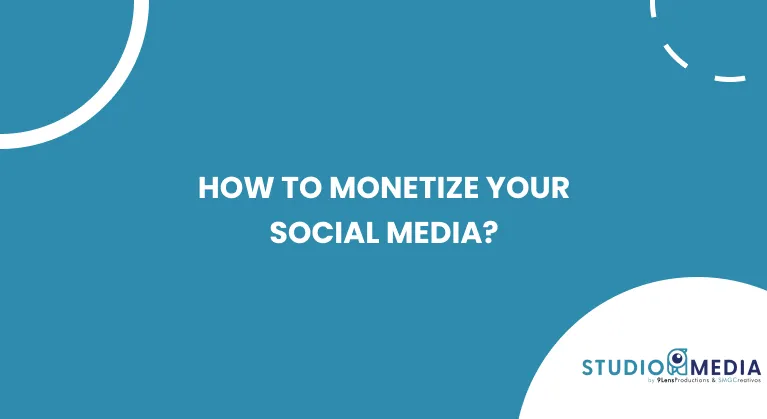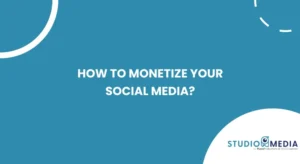Social media has become a powerful platform for generating income. What started as a way to connect people is now a complete ecosystem where you can build a profitable business if you apply the right strategies. From influencers to small businesses, monetizing social media is within reach for anyone willing to invest time and creativity. Below, we explore the most effective strategies for monetizing your social media presence, along with clear examples of how to implement them:
Define Your Niche and Attract Your Audience
The first essential step to monetizing social media is to define a niche. Instead of trying to appeal to everyone, it’s more effective to focus on a specific area where you have knowledge or passion. By defining your niche, you position yourself as an expert, and you can attract an audience that’s interested in the type of content you produce.
Example
If your passion is healthy cooking, you could create content focused on vegan recipes or low-carb diets. By focusing on a specific niche, such as «easy vegan recipes,» you can attract followers who are particularly interested in that type of food, making your posts and recommendations more valuable to them. For instance, you can offer daily recipes on Instagram, tutorials on YouTube, and then launch an ebook with exclusive recipes, generating income while reinforcing your credibility in the subject.
Create Attractive and Consistent Content
Content is the driving force behind any monetization strategy. To succeed on social media, you need to produce content that attracts and keeps your audience engaged. The key is to create posts that are visually appealing, informative, or entertaining. Additionally, consistency is crucial: posting regularly keeps your followers engaged and increases your visibility.
Example
If you have a YouTube channel dedicated to tech reviews, it’s vital that you publish videos consistently, at least once a week. Moreover, you need to ensure that your videos offer clear value, such as product comparisons, detailed analyses, or tutorials. A successful example would be creating a weekly series called «Tech in 5 Minutes,» where each episode reviews a new gadget. Consistency in publishing and the quality of the content will attract more subscribers, and you can eventually monetize through ads or affiliate marketing.
Direct Monetization: Sponsors and Collaborations
One of the most direct ways to monetize social media is through sponsors. If you have an engaged audience, brands will be interested in partnering with you to promote their products or services. Collaborations can range from a single sponsored post to long-term partnerships where you become a brand ambassador.
Example
Imagine you’re a fitness influencer with a sizable audience on Instagram. You could collaborate with a sportswear brand that pays you to post a photo using their gear during your workouts. The brand might also provide you with a discount code to share with your followers. If your followers trust your opinion, they’re more likely to use the code to make a purchase, generating income for both you and the brand. Over time, you could become an ambassador for the brand and secure a long-term contract, providing you with recurring income.
Affiliate Marketing: How to Earn Without Creating Your Own Product?
Affiliate marketing is a simple way to make money without having to create your own product. It involves recommending products from other companies to your audience and earning a commission for each sale made through your affiliate link.
Example
Let’s say you have a blog about gadgets and technology. You join an affiliate program like Amazon Associates and start including links to recommended products in your posts. If you write a review about a new smartphone and a reader buys that smartphone through your link, you’ll earn a commission from that sale. This system is beneficial because you don’t need to worry about inventory or shipping; you just focus on creating quality content that motivates your followers to click on your links and make purchases.
Sell Digital Products: A Scalable Source of Income
Digital products like ebooks, online courses, or downloadable templates are highly scalable. Once created, you can sell them repeatedly without additional production costs. This is an ideal option for people with skills or knowledge that can be shared.
Example
If you’re a graphic designer, you can create customizable resume templates or graphic packs and sell them on platforms like Etsy or your own website. Once you upload the templates, you can generate passive income every time someone buys them. Additionally, you can promote them on your social media channels, offering exclusive discounts to your followers, which will increase your sales and keep interest in your content high.
Sell Physical Products: Use Social Media as a Sales Channel
If you have a physical product to sell, social media is an ideal sales channel. Instagram, Facebook, and Pinterest allow for store integrations where users can purchase directly from the platform.
Example
Suppose you have an online clothing store. You can use Instagram Shopping to tag products in your posts, allowing your followers to purchase directly from the platform. Additionally, you can use Instagram stories to showcase how people are wearing your clothes in real life, offering a more personal and convincing touch. Customers can click directly on the product tags and be directed to your online store to complete the purchase.
Advertising and Marketing: Maximize Your Reach and Conversion
Paid advertising on social media is an excellent way to reach new audiences. Platforms like Facebook and Instagram Ads allow you to segment your audience based on interests, age, location, and other criteria, increasing the effectiveness of your marketing campaigns.
Example
Imagine you run an online beauty store and want to promote a new line of makeup. You can create Instagram ads targeting young women interested in cosmetics. Additionally, you can use retargeting tools, which show ads to people who have already visited your store but didn’t make a purchase, increasing the chances of conversion. With this strategy, you can significantly improve your sales rate by reaching an interested and potentially repeat audience.
Lives, Webinars, and Paid Events: Connect and Generate Income
Lives and webinars allow for closer and real-time interaction with your audience. You can use them to teach classes, give demonstrations, or simply connect with your followers. Additionally, you can charge for these events, either through tickets or prior registration.
Example
Suppose you’re a productivity coach. You could organize a webinar on how to better organize time and improve personal productivity. You could charge a registration fee for access to the event and also offer a discount on your consulting services at the end of the webinar. This strategy allows you to generate income both from the event itself and from future hires for your services.
Build a Paid Community: A Model for Recurring Income
Creating a paid community is another effective way to generate recurring income. Platforms like Patreon allow your followers to pay a monthly fee for access to exclusive content, from videos to private chats and more.
Example
A podcaster could create membership tiers on Patreon, where paying followers get early access to episodes, behind-the-scenes content, and live Q&A sessions. This paid membership not only generates steady income but also strengthens the bond with the most committed audience.
Social Media and Strategies: What Works Best on Each Platform?
Not all social media platforms are equal when it comes to monetization. Instagram, for example, is ideal for visual content, while YouTube works best for tutorials and long-form videos. Knowing the strengths of each platform will help you choose the best monetization strategy.
Example
A chef could use YouTube to publish detailed recipe videos and take advantage of the platform’s ad monetization system. At the same time, they could use Instagram to post tempting photos of their dishes and direct their followers to the YouTube videos. This integrated approach maximizes visibility and income opportunities.
Brand Collaborations: How to Become a Product Ambassador?
Becoming a brand ambassador is a step beyond occasional collaborations. Instead of one-off agreements, brands seek long-term relationships with influencers who consistently represent their products.
Example
If you’re a beauty influencer, a cosmetics brand could invite you to become an ambassador, which involves regularly promoting their products in your posts. This could include mentions in YouTube videos, Instagram photos, and exclusive promotions for your followers. As an ambassador, you might receive a fixed monthly salary and commissions for each sale generated through your posts.
Monetize Through Exclusive Content: Subscriptions and Memberships
Paid subscriptions allow you to offer exclusive content to your most loyal followers. This can include access to special videos, Q&A sessions, or content that isn’t shared publicly.
Example
A personal finance content creator could offer a private Facebook or Discord group where members pay a monthly fee to get exclusive advice, participate in personalized discussions, or access advanced budget templates.
Optimize the Use of Tools and Analytics to Boost Income
The use of analytics tools is essential to understanding how your content is performing. Analyzing metrics like engagement, follower growth, and sales conversions will help you optimize your strategy and maximize your income.
Example
If you manage an Instagram account, you can use Instagram Insights to see which types of posts generate the most interaction. If you notice that short videos get more likes and comments than photos, you can adapt your strategy to post more videos, which could increase your visibility and attract potential sponsors.
Growth Strategies: How to Expand Your Audience for Greater Monetization?
The larger your audience, the greater your monetization potential. Expanding your follower base not only increases visibility but also allows you to charge more for brand collaborations or increase product sales.
Example
A clear example is collaborating with other content creators to grow your audience. If you have a travel blog, you could partner with another influencer in the same niche to do a cross-collaboration, where each of you promotes the other’s content. This way, you can reach your collaborator’s audience and gain new followers who are interested in your content.
The Importance of Storytelling: Emotionally Connect with Your Audience
Storytelling is a powerful technique for emotionally connecting with your audience. Sharing personal stories or showing how you’ve overcome challenges can help you build a stronger bond with your followers and make them trust your recommendations more.
Example
A lifestyle influencer could share a personal story about how a change in their diet improved their health, and then recommend related products that helped them in their journey. This approach builds trust and makes the audience more likely to follow their product suggestions.
Automation and Delegation: How to Scale Your Social Media Presence
As your audience grows, automating certain tasks allows you to save time and be more efficient. Using tools to schedule posts and analytics or delegating tasks to a team will help you focus on creating higher-quality content.
Example
If you have a blog or an online store, you can use tools like Hootsuite to schedule automatic posts across all your social media platforms. This way, you free up time to interact with your audience in real-time or focus on creating new content without worrying about daily posts.
Offer Consulting or Coaching Services
If you have specialized knowledge in an area like marketing, business, or wellness, you can monetize your social media by offering personalized consulting or coaching sessions. Many people are willing to pay for direct access to experts who can help them improve in their areas of interest.
Example
A digital marketing expert could offer one-hour consulting sessions via Zoom, where they help entrepreneurs improve their social media marketing strategies. Through platforms like Instagram or LinkedIn, the expert can promote their services and attract potential clients.
Crowdfunding and Donations
Another monetization method is asking for donations or funding from your followers. This works especially well for content creators who offer free value and whose audience is willing to support them to continue creating.
Example
A podcaster could use platforms like Ko-fi or Buy Me a Coffee, where their followers can make small donations as a thank-you for the content they regularly consume. Additionally, the creator could offer exclusive rewards to donors, such as additional content or shout-outs in future episodes.
Host Giveaways and Promotions
Giveaways and promotions are an excellent way to interact with your audience and, at the same time, generate income through sponsors. Additionally, giveaways tend to increase your follower count and improve engagement on your posts.
Example
A beauty account on Instagram could host a giveaway in collaboration with several cosmetic brands. The brands contribute products for the prize, and in return, you give them visibility through your posts. Besides attracting new followers, you could receive compensation from the brands for organizing the giveaway.
Diversify and Maximize Your Income Streams on Social Media
Monetizing social media isn’t a one-way process; it requires creativity, consistency, and the ability to diversify your income streams. Whether through sponsored content, affiliate marketing, selling products or services, or creating paid communities, each strategy can help turn your social media presence into a profitable business. The key is knowing your audience, taking advantage of opportunities, and being adaptable to trends.







